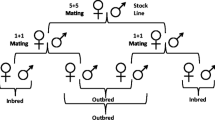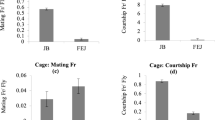Abstract
Frequency-dependent sexual selection was studied using three geographically isolated strains ofDrosophila melanogaster. The Oregon-R and Canton-Special wild-type strains were essentially homogeneous, having been maintained in laboratories since 1925; the wild Macomb strain was relatively genetically heterogeneous, having been collected in September 1972, immediately prior to this investigation. All possible double combinations of the three strains were placed in separate chambers of a modified Elens-Wattiaux observation apparatus at ratios of 5∶20, 12∶12, and 20∶5. Allowing 2 hr observation time for each chamber, data were collected to detect mating preference between these strains. There was no sexual isolation between the strains. However, frequency dependence, where rare males have a definite mating advantage in a population, was exhibited by the strains studied. Sexual vigor appeared to be a factor when the heterogeneous Macomb strain was mated to either of the two homogeneous strains in equal numbers.
Similar content being viewed by others
References
Averhoff, W. W., and Richardson, R. H. (1974). Pheromonal control of mating patterns inDrosophila melanogaster.Behav. Genet. 4:207–226.
Bösiger, E. (1962). Sur le degré d'hétérozygotie des populations naturelles deDrosophila melanogaster et son maintien par la seléction sexuelle.Bull. Biol. 96:3–122.
Ehrman, L. (1966). Mating success and genotype frequency inDrosophila.Anim. Behav. 14:332–339.
Ehrman, L. (1967). Further studies on genotype frequency and mating success inDrosophila.Am. Naturalist 101:415–424.
Ehrman, L. (1969). The sensory basis of mate selection inDrosophila.Evolution 23:59–64.
Ehrman, L. (1970). The mating advantage of rare males inDrosophila.Proc. Natl. Acad. Sci. 65:345–348.
Ehrman, L., and Petit, C. (1968). Genotype frequency and mating success inwillistoni species group ofDrosophila.Evolution 22:649–658.
Elens, A. A., and Wattiaux, J. M. (1964). Direct observation of sexual isolation.Drosophila Inform. Serv. 39:118–119.
Elens, A., Van Den Haute, J., and Delcour, J. (1973). Sexual vigor and sexual selection inDrosophila melanogaster.Evolution 27:549–557.
Faugeres, A., Petit, C., and Thibout, E. (1971). Components of sexual selection.Evolution 25:265–275.
Leonard, J. E., Ehrman, L., and Schorsch, M. (1974). Bioassay of aDrosophila pheromone influencing sexual selection.Nature 250:261–262.
Lindsley, D. L., and Grell, E. H. (1967).Genetic Variations in Drosophila melanogaster, Carnegie Institute of Washington Publication No. 627, p. 431.
Petit, C. (1958). Le determinisme génétique et psycho-physiologique de la competition sexuelle chezDrosophila melanogaster.Bull. Biol. 92:248–329.
Spiess, E., and Langer, B. (1964). Mating speed control by gene arrangement inDrosophila persimilis.Evolution 21:672–678.
Author information
Authors and Affiliations
Rights and permissions
About this article
Cite this article
Tardif, G.N., Murnik, M.R. Frequency-dependent sexual selection among wild-type strains ofDrosophila melanogaster . Behav Genet 5, 373–379 (1975). https://doi.org/10.1007/BF01073206
Received:
Accepted:
Issue Date:
DOI: https://doi.org/10.1007/BF01073206




